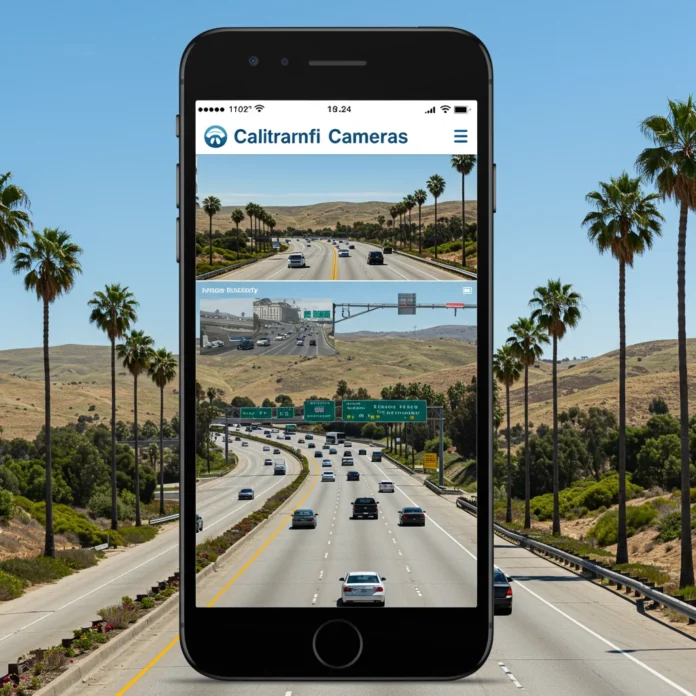Introduction to Caltrans Cameras
California’s highways pulse with constant motion, from the hum of early morning commuters to the vibrant energy of holiday travelers. Staying informed about current traffic conditions is essential for safe, efficient journeys. That’s where Caltrans cameras come in, offering a window into real-time road activity across the state. Whether we’re planning our daily commute, a scenic drive, or a cross-state adventure, these feeds provide the up-to-the-minute insights we need.
What Are Caltrans Cameras?
Caltrans cameras are strategically placed traffic monitoring devices managed by the California Department of Transportation. They capture live images and video of roadway conditions, enabling the public to view traffic flow, incidents, and weather impacts as they happen. These cameras serve as a vital tool for both travelers and traffic management authorities.
How Do Caltrans Cameras Work?
Caltrans installs these cameras along highways, bridges, and key intersections. They transmit real-time images to centralized control centers and make them available to the public through online platforms. Most cameras operate around the clock, capturing both still images and streaming video, depending on the location and camera type.
Each device is connected to a secure network, ensuring that the feeds remain reliable and accessible. The images are updated frequently, giving users a nearly live view of California’s roadways.
Why Use Caltrans Cameras for Traffic Updates?
Checking Caltrans camera feeds before heading out can save significant time and frustration. These cameras offer transparent, unbiased views of current conditions, allowing us to make informed decisions about when and where to travel.
Unlike radio reports or static maps, live feeds provide visual confirmation of slowdowns, closures, or accidents. This empowers us to adjust our routes and avoid unnecessary delays.
History and Evolution of Caltrans Traffic Cameras
The first Caltrans cameras appeared decades ago as basic black-and-white surveillance tools. Over time, advances in digital imaging and networking have transformed them into sophisticated, high-resolution devices. Today’s network spans thousands of miles and integrates with advanced traffic management systems.
As experts often say:
“Real-time traffic observation is one of the most effective ways to promote safer and more efficient travel for everyone on the road.”
Continuous upgrades have improved reliability, coverage, and image quality, making Caltrans cameras indispensable for modern transportation planning.
Where Are Caltrans Cameras Located?
Caltrans cameras are positioned to monitor critical transportation corridors, urban bottlenecks, rural stretches, and major bridges. Their placement is based on traffic volume, accident history, and the need for real-time oversight.
Which Major Highways Are Covered by Caltrans Cameras?
The Caltrans camera network spans iconic routes such as Interstate 5, Highway 101, Interstate 80, and State Route 99. These highways are lifelines for commerce and daily travel, making constant monitoring essential.
Many cameras also provide coverage of important bridges. For instance, travelers interested in the Bay Bridge live views and traffic updates can access feeds to monitor congestion and plan crossings.
How Do Urban and Rural Coverage Differ?
Urban areas like Los Angeles, San Francisco, and Sacramento feature denser camera placement due to higher traffic volumes. In contrast, rural highways and mountainous regions have fewer cameras, typically focused on key junctions and weather-prone zones.
How Can You Find a Caltrans Camera Location?
The official Caltrans QuickMap, website, and mobile app all provide interactive maps showing camera locations. Users can search by highway, city, or region to pinpoint specific feeds that will help them plan their journey.
How to Access Caltrans Cameras Online
Accessing Caltrans camera feeds is straightforward, thanks to several user-friendly platforms. Whether we prefer desktop browsing or mobile convenience, there’s a solution for everyone.
How Do You Use the Official Caltrans Website?
The Caltrans website offers a comprehensive traffic camera map. Users simply visit the site, select the “Cameras” layer, and click on camera icons to view current images.
What Is the Caltrans QuickMap and How Does It Work?
Caltrans QuickMap is an interactive, real-time map that displays cameras alongside other traffic data such as incidents, roadwork, and lane closures. Users can filter by region, route, or camera type for a personalized experience.
Is There a Caltrans Mobile App?
Yes, the Caltrans QuickMap mobile app is available for both iOS and Android devices. The app’s intuitive interface makes it easy to check traffic conditions, view live camera feeds, and receive notifications about incidents or road hazards.
Are There Third-Party Websites and Apps with Caltrans Feeds?
Several third-party services aggregate Caltrans camera feeds and supplement them with additional data, such as crowd-sourced traffic reports or GPS navigation integration. These platforms can be helpful for users seeking an all-in-one travel planning tool.
For those planning to book activities or find tours, platforms like Viator also offer helpful travel resources alongside essential transportation updates.
How to Check Real-Time California Traffic with Caltrans Cameras
Caltrans cameras are designed for ease of use, whether you are a daily commuter or an occasional traveler. Following a few simple steps can provide you with a clear picture of current road conditions.
What Steps Should You Follow to View Live Feeds?
To check real-time traffic using Caltrans cameras:
- Visit the Caltrans QuickMap or website.
- Select the “Cameras” layer on the map interface.
- Zoom in to your area of interest.
- Click on a camera icon to view the latest image or video.
How Can You Filter Cameras by Region or Route?
Filtering options let users narrow down cameras by specific highways, counties, or metro areas. This targeted approach saves time and delivers only the most relevant traffic information.
How Should You Interpret Camera Images Effectively?
Look for signs of congestion, stopped vehicles, or emergency response activity. Weather conditions—such as fog, rain, or snow—may also be visible, helping travelers anticipate driving challenges.
For example, before setting out on a San Francisco Bay cruise, checking nearby cameras can reveal potential delays on approach routes.
What Do Camera Symbols and Map Icons Mean?
Each camera icon on the map represents a live feed. Different colors or shapes may indicate camera type (fixed or pan-tilt-zoom) or status (active, under maintenance, or offline). Hovering or tapping on an icon reveals additional details.
How Often Are Caltrans Camera Feeds Updated?
Most Caltrans camera feeds update every few seconds, providing near real-time snapshots. Some cameras offer streaming video with minimal delay, while others refresh images at regular intervals. Update frequency depends on camera type and network bandwidth.
What Types of Cameras Does Caltrans Use?
Caltrans employs a mix of camera technologies to address the diverse needs of California’s roadways. Each type serves a unique purpose in monitoring traffic flow and safety.
What Is the Difference Between Fixed and Pan-Tilt-Zoom Cameras?
Fixed cameras focus on a single direction or location, making them ideal for monitoring specific stretches of highway. Pan-tilt-zoom (PTZ) cameras can be remotely controlled to swivel, tilt, and zoom, offering a broader field of view and the ability to track incidents dynamically.
How Good Is the Camera Image Quality and Resolution?
Modern Caltrans cameras deliver high-resolution images, often in color and even low-light conditions. This clarity allows us to distinguish vehicle types, lane markings, and weather impacts with confidence.
Are Caltrans Cameras Live or Delayed?
Most feeds are live or nearly live, with only minor delays due to network transmission or processing. In rare cases, technical issues may introduce brief lags, but updates remain frequent enough for effective travel planning.
Privacy and Security Considerations
Caltrans is committed to protecting both public safety and individual privacy. Extensive safeguards are in place to ensure that camera footage is used appropriately and securely.
Are Caltrans Cameras Recording Video?
The majority of Caltrans cameras do not record or archive video for public access. They are intended for real-time monitoring and traffic management, not for long-term surveillance.
How Is Your Data Protected?
All camera feeds are transmitted over secure networks. Access to control and management systems is restricted to authorized personnel. Caltrans adheres to strict policies to prevent misuse of collected data.
Can the Public Access Camera Archives?
Caltrans generally does not provide public access to archived footage. Exceptions may be made for law enforcement investigations or specific safety studies, but routine historical access is not available.
Benefits of Using Caltrans Cameras for Commuters
For millions of Californians, Caltrans cameras are a daily resource for smarter, safer travel. The benefits extend to all types of road users.
How Can You Save Time on Your Commute?
By checking cameras before departure, we can avoid congested routes and select the fastest path to our destination. This proactive approach often results in shorter, less stressful commutes.
How Do Caltrans Cameras Help You Avoid Traffic Jams and Accidents?
Live camera images reveal developing backups and accident scenes in real time. By observing these feeds, we can reroute and minimize delays, especially during peak travel periods.
Travelers heading to popular destinations, such as Universal Studios Hollywood, can benefit from checking traffic cameras along key corridors to time their arrival perfectly.
How Can You Plan Alternate Routes?
If a preferred route is blocked by construction, collisions, or weather, Caltrans cameras make it easy to scout alternate roads. This flexibility helps us stay on schedule and avoid unnecessary detours.
What Are the Benefits for Truckers and Commercial Drivers?
Commercial drivers rely on accurate, real-time data to meet delivery schedules and comply with safety regulations. Caltrans cameras assist with route planning, detour management, and compliance with road closures or chain requirements.
How Caltrans Cameras Help During Emergencies
During emergencies, Caltrans cameras become indispensable for both the public and responders. They provide vital situational awareness when every minute counts.
How Do Cameras Assist During Wildfires and Natural Disasters?
Caltrans cameras monitor evacuation routes and hazard zones during wildfires, floods, or earthquakes. This real-time visibility supports timely, informed decisions for both emergency personnel and evacuees.
How Are Major Accidents and Road Closures Managed?
First responders and Caltrans operators use live feeds to coordinate response efforts, clear incidents, and restore normal traffic flow as quickly as possible.
How Do Cameras Help with Weather-Related Traffic Issues?
Snow, fog, rain, and high winds can create hazardous driving conditions. Caltrans cameras let us see these impacts firsthand, allowing for better preparation and safer journeys.
Using Caltrans Cameras for Trip Planning
Whether we’re setting out on a cross-state drive or heading to a local attraction, Caltrans cameras play a key role in trip preparation.
How Can You Check Road Conditions Before Traveling?
A quick review of camera feeds reveals current traffic, weather, and construction along your planned route. This helps us avoid surprises and travel with peace of mind.
How Can You Monitor Traffic During Holidays and Events?
Holiday weekends and special events can cause sudden surges in traffic. Monitoring cameras near venues or major exits allows us to anticipate delays and adjust departure times accordingly.
For those heading to the waterfront for a Golden Gate cruise adventure, checking local Caltrans cameras can make the arrival smoother and more enjoyable.
Integrating Caltrans Camera Feeds with Navigation Apps
Many travelers prefer to combine live camera data with navigation apps for a comprehensive travel planning experience.
Can You Add Caltrans Cameras to Google Maps or Waze?
While Google Maps and Waze do not natively display Caltrans camera feeds, users can cross-reference camera locations with their GPS routes. Some third-party apps integrate both data sources for added convenience.
What Are the Best Tips for Combining Camera Feeds with GPS Directions?
We recommend checking camera feeds before starting navigation, especially for longer trips. If significant delays or hazards are visible, adjust your route in your GPS app to avoid affected areas.
Common Issues When Accessing Caltrans Cameras
While Caltrans strives for reliable service, technical challenges can occasionally arise. Understanding common issues ensures a smoother user experience.
How Can You Troubleshoot Website and App Problems?
If camera feeds do not load, try refreshing the page, clearing your browser cache, or restarting the app. Checking your internet connection can also resolve many issues.
Why Might a Camera Feed Be Unavailable?
Feeds may be temporarily offline for maintenance, upgrades, or due to power outages. Some cameras are also switched off during low-traffic periods to conserve resources.
Who Should You Contact for Technical Support?
The Caltrans website provides contact information for technical assistance. Reaching out directly ensures timely resolution of persistent problems.
Accessibility Features of Caltrans Camera Platforms
Caltrans is committed to making its camera platforms accessible to all users, regardless of ability or device.
Are Caltrans Camera Feeds ADA-Compliant?
The main platforms are designed with accessibility in mind, including keyboard navigation and screen reader compatibility for visually impaired users.
What Language and Translation Options Are Available?
Some Caltrans platforms offer translation tools or language selection menus, helping non-English speakers access vital traffic information.
What Mobile Accessibility Tips Should You Know?
For the best experience, use the official Caltrans QuickMap app, which is optimized for touch navigation and accessible features on modern smartphones.
How Caltrans Cameras Support Law Enforcement and Emergency Responders
Beyond public use, Caltrans cameras are invaluable for law enforcement and emergency management.
Do Police Use Caltrans Camera Footage?
Yes, police and highway patrol officers may use live feeds to monitor traffic, detect incidents, and coordinate responses. However, access to archived footage remains limited for privacy reasons.
How Are Cameras Used in Incident Management?
Traffic management centers rely on camera feeds to verify incident reports, deploy resources, and update the public with accurate information.
What Are Caltrans Cameras’ Roles in Public Safety Initiatives?
Cameras support a range of public safety efforts, including Amber Alerts, hazardous material spills, and large-scale event security. Their real-time perspective enhances situational awareness and rapid response.
Future of Caltrans Cameras and Traffic Monitoring
Caltrans continues to invest in new technologies and expanded coverage to meet California’s evolving transportation needs.
What Technology Improvements Are on the Horizon?
Upcoming upgrades include higher-resolution imaging, artificial intelligence for incident detection, and integration with connected vehicle infrastructure.
Are There Plans to Expand Camera Coverage?
Expansion projects are underway to fill coverage gaps, especially in rural and mountainous regions where timely data is critical during emergencies.
How Will Cameras Integrate with Smart City Solutions?
Future plans call for deeper integration with smart traffic signals, autonomous vehicle networks, and citywide mobility platforms, further enhancing the efficiency of California’s transportation system.
For inspiration on how advanced monitoring transforms travel experiences, consider how similar innovations are highlighted in our Kennedy Space Center visitor’s guide.
Frequently Asked Questions About Caltrans Cameras
We answer some of the most common questions to help you get the most out of Caltrans cameras.
Are Caltrans Cameras Available 24/7?
Most camera feeds operate around the clock, with only occasional downtime for maintenance or technical issues.
Can I Request a New Camera Location?
Caltrans welcomes public feedback and occasionally adds cameras based on community need or safety priorities. Formal requests can be submitted via their website.
How Accurate Are the Camera Feeds?
Caltrans camera images are highly accurate, reflecting real-time conditions within seconds of capture. However, occasional delays may occur during heavy network usage or technical disruptions.
Tips for Getting the Most Out of Caltrans Cameras
A few simple strategies can help maximize the value of Caltrans camera feeds for your daily commute or next adventure.
When Is the Best Time to Check Cameras for Clear Traffic?
Checking cameras outside of peak rush hours—early morning or late evening—often provides the clearest view of traffic-free roads.
How Can You Bookmark Favorite Camera Locations?
Most platforms allow users to save or bookmark frequently viewed cameras for quick access. This feature is especially helpful for regular commuters or those monitoring specific routes.
How Do You Set Up Alerts and Notifications?
The Caltrans QuickMap app supports customizable alerts for incidents, closures, or traffic slowdowns on your selected routes.
User Stories: How Real People Use Caltrans Cameras
Everyday Californians rely on these cameras for a variety of reasons, from daily commutes to long-haul journeys.
What Are Commuter Experiences?
Many commuters tell us they check Caltrans cameras each morning to choose the quickest route, avoiding bottlenecks and arriving at work on time.
How Do Long-Distance Travelers Benefit?
Vacationers and road trippers use camera feeds to monitor conditions along scenic highways, ensuring a smooth and enjoyable trip.
What Are Commercial Driver Perspectives?
Truck drivers appreciate the ability to monitor weather-prone passes and construction zones, allowing for safer and more efficient deliveries across the state.
How to Provide Feedback or Report Issues to Caltrans
Caltrans values user input and provides several avenues for feedback and support.
What Are the Contact Methods for Caltrans?
Users can contact Caltrans via email, phone, or online forms available on their official website. Prompt communication helps resolve technical issues and improve service.
How Can You Participate in Public Surveys?
Occasionally, Caltrans conducts public surveys to gather feedback on camera coverage, usability, and desired features. Participating helps shape the future of California’s traffic monitoring system.
How to Book on Viator
If your travel plans include sightseeing or special experiences, Viator makes it easy to book activities, tours, and excursions across California. Simply visit their website, search for your destination, and browse a curated list of options with real-time availability.
Viator’s platform allows you to review ratings, compare prices, and secure your spot with just a few clicks. It’s a convenient way to plan your trip and add memorable adventures to your itinerary.
Conclusion: Making the Most of Caltrans Cameras for Safer, Smarter Travel
Staying informed with Caltrans camera feeds empowers us to travel smarter, safer, and with greater confidence. By leveraging these real-time insights, we can minimize delays, avoid hazards, and make every journey more enjoyable.
At Izase, we believe in equipping travelers with the best tools for the road ahead. For more expert travel guidance, visit Izase and discover resources designed to support your next adventure.
“Disclaimer: This information is accurate to the best of our knowledge; however, there may be changes or mistakes. Please verify exact details on the Viator booking page.”


